
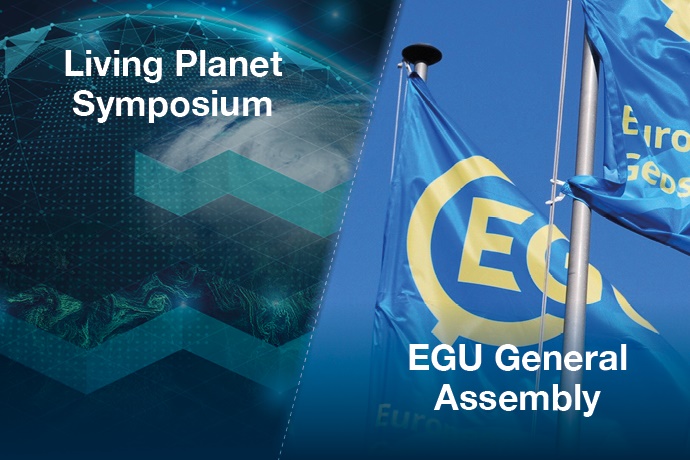
Right-hand image © EGU, licensed under CC Attribution 4.0.
Almost 40 ECMWF scientists took part in the European Space Agency’s 2022 Living Planet Symposium (LPS) in Bonn, Germany, from 23 to 27 May, and some 15 scientists contributed to the annual General Assembly of the European Geosciences Union (EGU) being held at the same time in Vienna, Austria, and online.
Their presentations and contributions to discussions at the LPS included the role of Earth observation in weather prediction, climate services and atmospheric composition monitoring, as well as emerging technologies. At the EGU, they covered land–atmosphere interactions, data assimilation techniques, sub-seasonal to seasonal predictions, and storm-resolving simulations.
“This was an extremely packed week, full of presentations covering the latest science in some of our core fields as well as presentations on ESA’s plans for the upcoming years in the Earth Observation programme,” ECMWF Director-General Florence Rabier says. “We presented updates on our regular research programme for medium-range weather prediction as well as results from the two Copernicus services on atmospheric composition and climate change which we run for the EU, and our plans for the EU’s new Destination Earth initiative.”
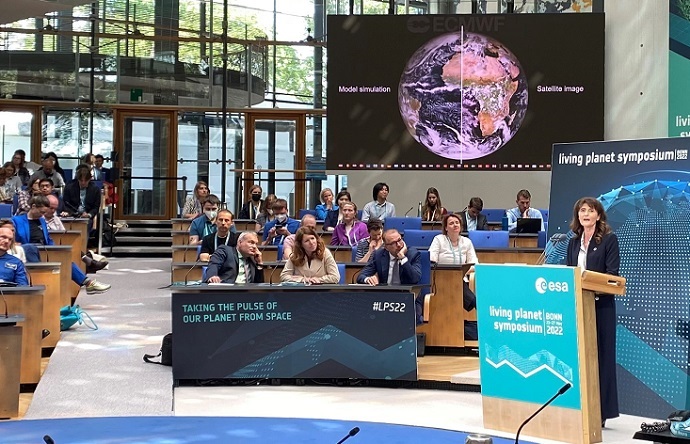
ECMWF Director-General Florence Rabier addressed the LPS during the opening session on 23 May.
Living Planet Symposium
Patricia de Rosnay says ECMWF’s presence at the LPS was exceptionally strong. “It was a great feeling to attend such an excellent conference in person, and to catch up with so many colleagues from other institutes across Europe and even from outside Europe,” she says.
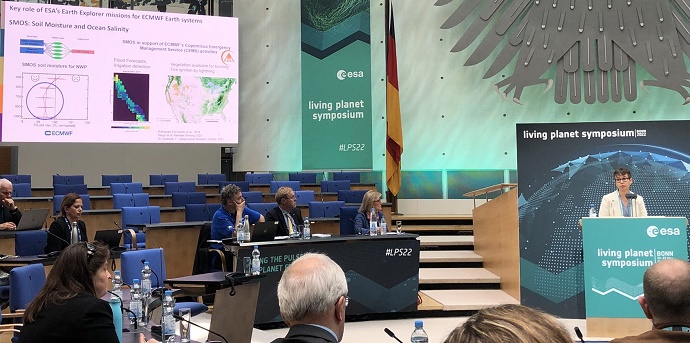
Patricia de Rosnay gave a talk on how ESA's observations are important to ECMWF activities. She also presented a poster on coupled land–atmosphere data assimilation.
Nils Wedi and Peter Lean gave a presentation on the use of high-performance computing (HPC) for Earth observations. “We described our daily operational HPC use in meteorology and climate applications, while connecting with Destination Earth developments towards implementing the first two digital twins of the Earth system on weather-induced extremes and climate adaptation,” Nils says.

Nils Wedi at the LPS in Bonn.
Vasileios Baousis gave a talk on improving the end-user uptake of Earth Observation and Copernicus data services. He also touched on ECMWF's contribution to the new Destination Earth (DestinE) initiative, which was explained in greater detail by Irina Sandu.
Irina co-chaired the session on digital twins and gave an overview of the two digital twins ECMWF will deliver in DestinE and the underpinning science elements.
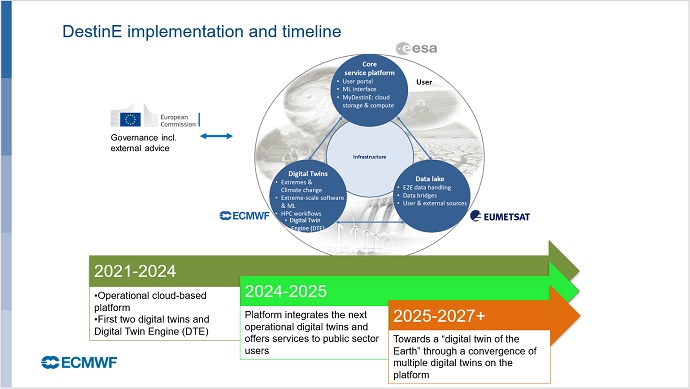
Vasileios Baousis and Irina Sandu highlighted in their talks the timeline of the DestinE initiative, in which ECMWF is involved together with ESA and EUMETSAT.
Other talks included one by Stijn Vermoote on experience from user uptake in the Copernicus Atmosphere Monitoring Service (CAMS) and the Copernicus Climate Change Service (C3S). “The fact that we are close to the data helps to really understand users’ needs and to create added value,” he says.

Stijn Vermoote gave a presentation on user uptake in CAMS and C3S.
Souhail Boussetta introduced the land vegetation work in the EU’s Horizon 2020 CONFESS project. He explained the use of multi-annual ESA-CCI land-use products and their potential impact in ECMWF’s ECLand system. “I showed the importance of considering inter-annual variability of vegetation, especially for monitoring extreme events such as droughts.”
Supercomputing was also represented, with a discussion on quantum computing, neuromorphic computing and heterogenous systems in which ECMWF’s Director of Computing, Martin Palkovic, took part.
A full breakdown of all LPS talks and discussions in which ECMWF scientists were involved can be found on our website.
European Geosciences Union
Our presence at the EGU General Assembly was partly on-site and partly virtual.

In a session on land–atmosphere interactions and climate extremes co-convened by Gianpaolo Balsamo, several presentations covered diverse geographical regions and illustrated the land–atmosphere mechanism involved in generating extremes.
Jasper Denissen gave a highlight presentation on how the climate shift towards water limitation in ecosystems exacerbates hot temperature extremes. “Jasper is about to defend his PhD and he will join the ECMWF team from July to work on the DestinE programme,” Gianpaolo explains.
Sam Hatfield chaired a session on high-resolution weather and climate modelling. Seventeen researchers from around the world presented results relating to storm-resolving atmospheric models.
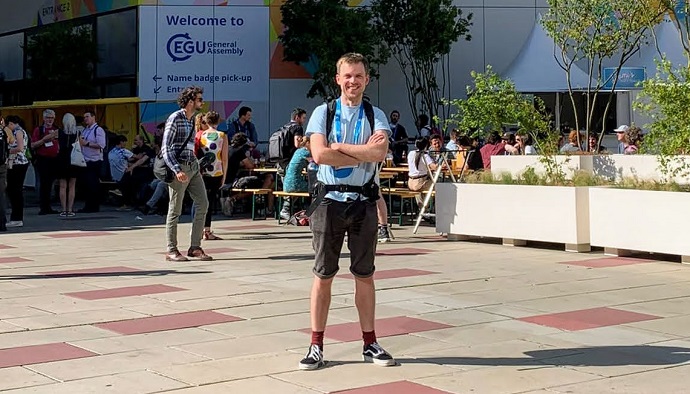
Sam Hatfield chaired a session on high-resolution weather and climate modelling at the EGU General Assembly.
“This was my first session convened in person,” Sam says, “and it was a great success, with around 80 combined online and on-site attendees.”
As part of this session, Thomas Rackow virtually presented an overview of global coupled storm-resolving simulations performed so far in the Horizon 2020 Next Generation Earth Modelling Systems (nextGEMS) project. “The project aims to build a new generation of eddy- and storm-resolving global coupled Earth system models,” he says.
The video shows wind gusts for 2.5 months simulated by ECMWF’s Integrated Forecasting System with a resolution of 4 km.
Mark Fielding gave a virtual talk in which he emphasised the importance of high-resolution observations for numerical weather prediction. His presentation highlighted ESA’s EarthCARE (Cloud Aerosol and Radiation Explorer) mission, which is expected to be launched in 2023.
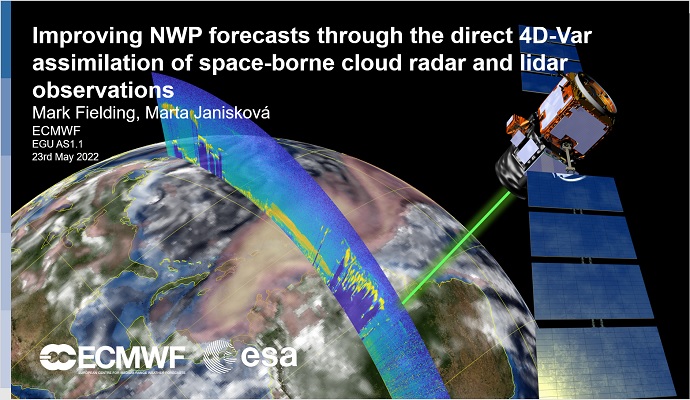
“I pointed out that EarthCARE could play a key role in helping to develop, evaluate and initialise the global storm resolving simulations beginning to be run in DestinE and beyond,” he says.
Margarita Choulga gave a virtual presentation on representing seasonal water in ECMWF’s ECLand system. “We showed that the use of up-to-date glacier and inland water distribution and mean depth can on average globally reduce skin temperature error by 0.5 K,” she says. “In addition, a monthly varying water distribution and separation of freshwater and salt water lakes gives an extra 0.3 K error reduction globally.”
A full breakdown of all EGU talks and discussions in which ECMWF scientists were involved can be found on our website.
